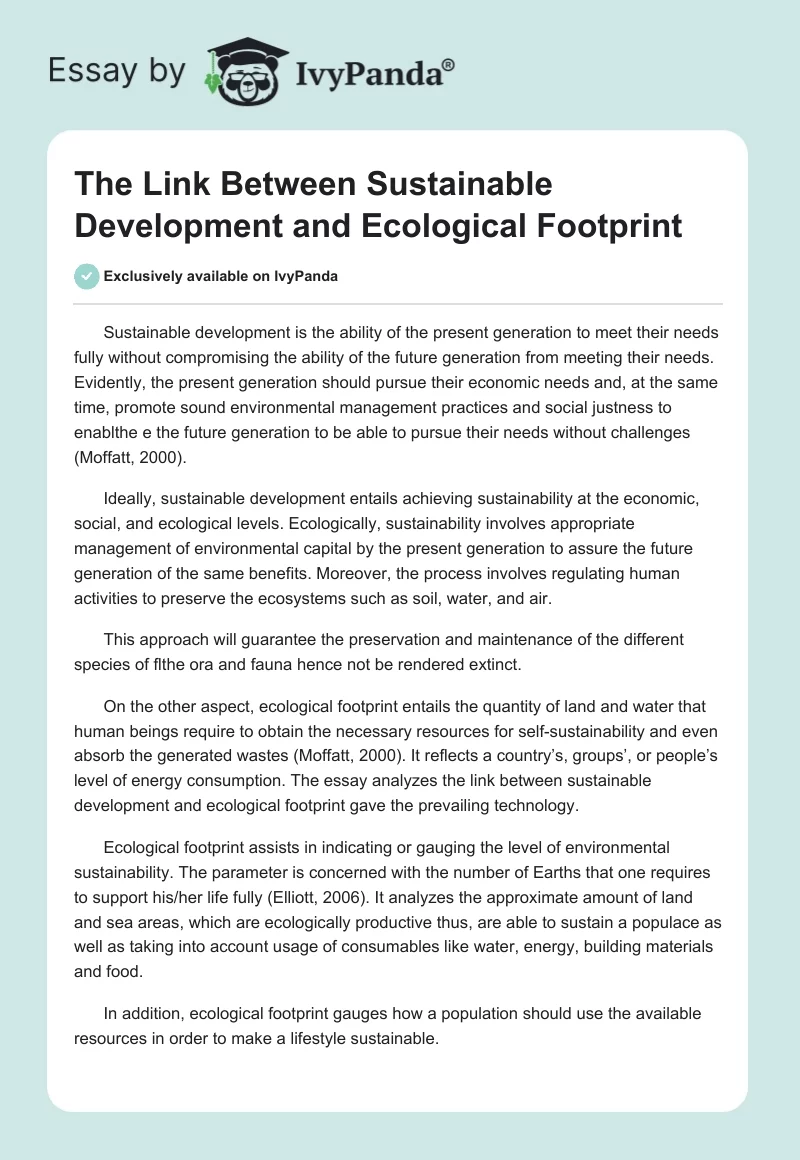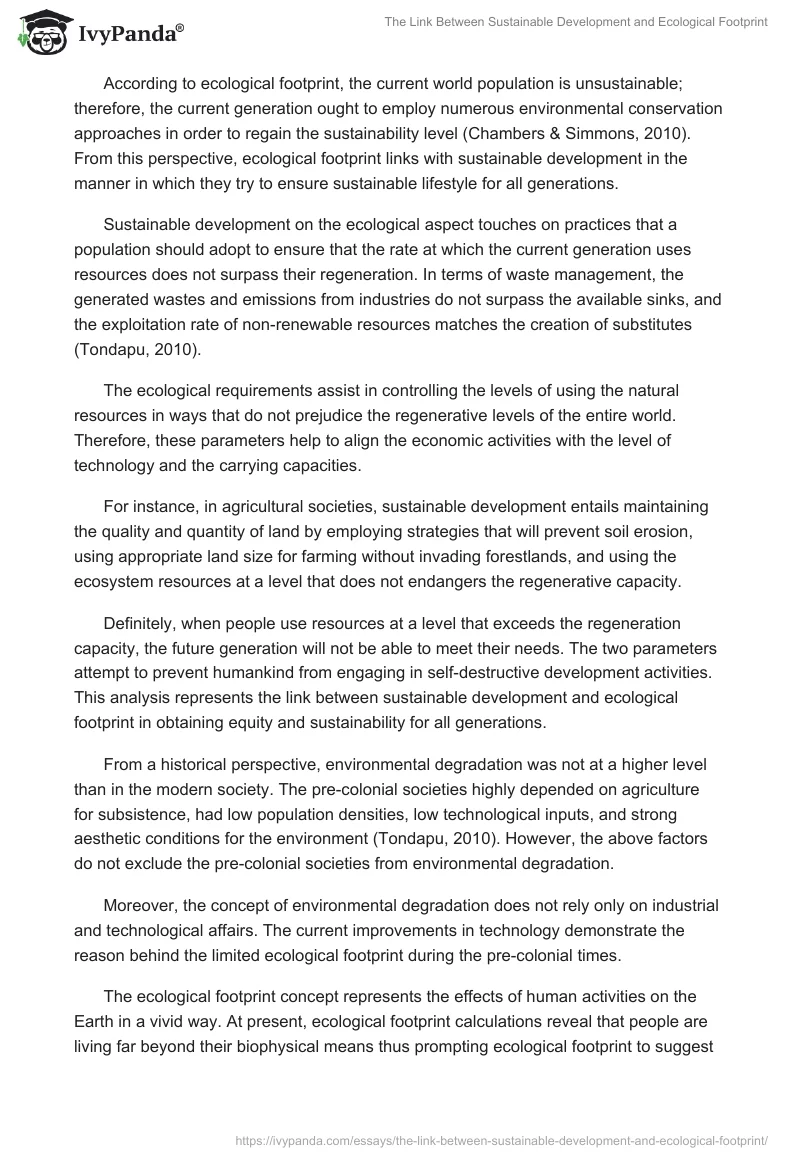Sustainable development is the ability of the present generation to meet their needs fully without compromising the ability of the future generation from meeting their needs. Evidently, the present generation should pursue their economic needs and, at the same time, promote sound environmental management practices and social justness to enablthe e the future generation to be able to pursue their needs without challenges (Moffatt, 2000).
Ideally, sustainable development entails achieving sustainability at the economic, social, and ecological levels. Ecologically, sustainability involves appropriate management of environmental capital by the present generation to assure the future generation of the same benefits. Moreover, the process involves regulating human activities to preserve the ecosystems such as soil, water, and air.
This approach will guarantee the preservation and maintenance of the different species of flthe ora and fauna hence not be rendered extinct.
On the other aspect, ecological footprint entails the quantity of land and water that human beings require to obtain the necessary resources for self-sustainability and even absorb the generated wastes (Moffatt, 2000). It reflects a country’s, groups’, or people’s level of energy consumption. The essay analyzes the link between sustainable development and ecological footprint gave the prevailing technology.
Ecological footprint assists in indicating or gauging the level of environmental sustainability. The parameter is concerned with the number of Earths that one requires to support his/her life fully (Elliott, 2006). It analyzes the approximate amount of land and sea areas, which are ecologically productive thus, are able to sustain a populace as well as taking into account usage of consumables like water, energy, building materials and food.
In addition, ecological footprint gauges how a population should use the available resources in order to make a lifestyle sustainable.
According to ecological footprint, the current world population is unsustainable; therefore, the current generation ought to employ numerous environmental conservation approaches in order to regain the sustainability level (Chambers & Simmons, 2010). From this perspective, ecological footprint links with sustainable development in the manner in which they try to ensure sustainable lifestyle for all generations.
Sustainable development on the ecological aspect touches on practices that a population should adopt to ensure that the rate at which the current generation uses resources does not surpass their regeneration. In terms of waste management, the generated wastes and emissions from industries do not surpass the available sinks, and the exploitation rate of non-renewable resources matches the creation of substitutes (Tondapu, 2010).
The ecological requirements assist in controlling the levels of using the natural resources in ways that do not prejudice the regenerative levels of the entire world. Therefore, these parameters help to align the economic activities with the level of technology and the carrying capacities.
For instance, in agricultural societies, sustainable development entails maintaining the quality and quantity of land by employing strategies that will prevent soil erosion, using appropriate land size for farming without invading forestlands, and using the ecosystem resources at a level that does not endangers the regenerative capacity.
Definitely, when people use resources at a level that exceeds the regeneration capacity, the future generation will not be able to meet their needs. The two parameters attempt to prevent humankind from engaging in self-destructive development activities. This analysis represents the link between sustainable development and ecological footprint in obtaining equity and sustainability for all generations.
From a historical perspective, environmental degradation was not at a higher level than in the modern society. The pre-colonial societies highly depended on agriculture for subsistence, had low population densities, low technological inputs, and strong aesthetic conditions for the environment (Tondapu, 2010). However, the above factors do not exclude the pre-colonial societies from environmental degradation.
Moreover, the concept of environmental degradation does not rely only on industrial and technological affairs. The current improvements in technology demonstrate the reason behind the limited ecological footprint during the pre-colonial times.
The ecological footprint concept represents the effects of human activities on the Earth in a vivid way. At present, ecological footprint calculations reveal that people are living far beyond their biophysical means thus prompting ecological footprint to suggest how to transform the present society onto directions of equitable, economically prudent, and ecologically sensible sustainable development.
Sustainable development links with the concept of ecological footprint in desiring to make development sustainable for both the present and future generations. Additionally, the ability of ecological footprint to determine the Human Development Index (HDI) enables us to note the number of poor population in the developing nations and the underclass population in the developed nations (Wackernagel & Rees, 1996).
This has assisted in sustainable development as we can determine the units of land per capita that is required to provide a flow of goods, capital, and pollution in and out of the areas. Ecological footprint diminishes when one reduces the throughputs and uses environmentally friendly technological practices efficiently.
Other suggestions like cutting the consumption per head, reducing population, and putting idle land into use can improve sustainable development.
The two parameters explore in details the intragenerational and intergenerational equity. The report on unsustainability of the present human development illustrates that sustainable development needs to institute pointers that can show whether their present actions are progressing towards or away from a sustainable future.
The present generation must consider using means, which are desirable and achievable in the dimensions of equity, economy, and ecology since a recommendation by Wackernagel & Rees (1996) to have another Earth is impossible. Ecological footprint relates the rate at which nature can replace the used resources on the environment to the consumption levels of the present generation.
Economically, it compares the demand of human beings and the supply rate of nature on biocapacity. Historically, the balancing act of these two factors have been at par with each other until 1970 when the human annual demand on nature surpassed the quantity that the Earth could regenerate annually. According to the findings on the ecological footprint, the Earth takes 1.5 years to regenerate what human beings consume in a year.
This phenomenon is dubbed Ecological overshoot. It is a huge threat to humans and the entire planet. Human population balances the act of demand and supply of resources by liquidating the resources of the globe. As a result, it requires adequate attention; for instance, by analyzing an individual’s pressure on Earth hence managing the ecological assets wisely.
Evidently, these processes demand collective and personal action to support a globe where all human lives within the Earth’s capacities to regenerate the resources. Specifically, sustainable development views a scenario where human beings will live in the world and fulfill all their needs without corrupting the Earth. This is the ultimate goal of ecological footprint. In this manner, the link between sustainable development and ecological footprint is evident.
Even though the two parameters attempt to link towards a sustainable future, some nations are not meeting their minimum requirements on sustainable development. Ecological footprint as an indicator of sustainable development provides data and metrics that decision makers use in setting targets, trends and expected outcomes (Footprint Basics – Overview, 2012).
On the business front, ecological footprint assists in supplementing sustainable development by enabling corporations to use environmentally friendly strategies. Businesses are able to set environmental benchmarks, initiate quantitative strengths, and evaluate different alternatives in order to minimize degrading the environmental resources.
Ecological footprint analysis assists in identifying business options that will thrive in the present resource-constrained world. Therefore, this parameter can foresee the limited resources that businesses may require in the future such as energy. On the development of cities, ecological footprint has been able to track the consumption rate of natural capital and other resources.
Some of the natural capital includes energy, healthy food, shelter, clothing, and clean water (Elliott, 2006). Ecological footprint tries to guard the overuse of natural capital to ensure that nature can secure the society in the future. This process helps in guaranteeing sustainable development for both the present and future generations.
The present generation should understand that the Earth belongs even to the future generation. Therefore, they should use the resources in a way that does not rule out the ability of the future generations from meeting their own needs. Ecological footprint has elaborated the close link that it has with sustainable development.
Its numerous data serve as indicators to the present generation in using resources at a rate that does not exceed the regeneration capacity of the Earth in order to live a sustainable life. Therefore, the link between sustainable development and ecological footprint is analyzed exclusively in the essay.
References
Chambers, N., & Simmons, C. (2010). Sharing nature’s interest: ecological footprints as an indicator of sustainability. London: Middlesex University.
Elliott, J. A. (2006). An introduction to sustainable development (3rd ed.). London: Kingston University.
Footprint Basics – Overview. (2012, February 15). Global Footprint Network. Retrieved May 21, 2013, from www.footprintnetwork.org/en/index.php/gfn/page/footprint_basics_overview/
Moffatt, I. (2000). Ecological footprints and sustainable development. Ecological Economics 3, 32, 359-362. Retrieved May 21, 2013, from the washington.edu database.
Tondapu, G. S. (2010, July 15). Ecological Footprint and Sustainable Development. bepress.com. Retrieved May 21, 2013, from works.bepress.com/gautami_tondapu/1/
Wackernagel, M., & Rees, W. E. (1996). Our ecological footprint: reducing human impact on the earth. Gabriola Island, BC: New Society Publishers.


